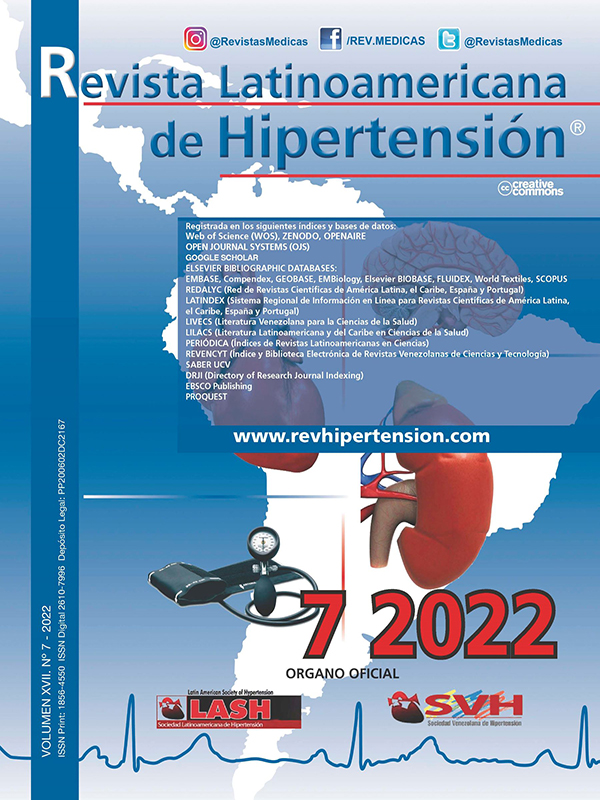Anticoagulantes orales en pacientes con fibrilación auricular: evidencia actual
Resumen
La fibrilación auricular (FA) es el subtipo de arritmia cardíaca más prevalente y confiere numerosos riesgos para los pacientes, especialmente incrementando la probabilidad de ictus isquémico. Por tal motivo, es necesario buscar alternativas terapéuticas que permitan disminuir los riesgos más allá del control del ritmo del corazón, en particular la anticoagulación. Los anticoagulantes orales han tenido un rol emergente en este renglón terapéutico, a pesar de la aparente ausencia de beneficios tromboprofilácticos a largo plazo. En este contexto se presentan numerosas opciones, entre las cuales se diferencian la warfarina y los nuevos anticoagulantes orales. El objetivo de esta revisión es establecer los pros y contras del uso de anticoagulantes orales en contraste con los anticoagulantes parenterales, con la finalidad de terminar su viabilidad en el manejo de pacientes con FA en riesgo de desarrollar eventos isquémicos
Descargas
Citas
Lloyd-Jones D, Adams RJ, Brown TM, Carnethon M, Dai S, De Simone G, et al. Executive Summary: Heart Disease and Stroke Statistics—2010 Update: A Report From the American Heart Association. Circulation. 23 de febrero de 2010;121(7):948-54.
Schnabel RB, Yin X, Gona P, Larson MG, Beiser AS, McManus DD, et al. 50 year trends in atrial fibrillation prevalence, incidence, risk factors, and mortality in the Framingham Heart Study: a cohort study. Lancet. 11 de julio de 2015;386(9989):154-62.
Benjamin EJ, Muntner P, Alonso A, Bittencourt MS, Callaway CW, Carson AP, et al. Heart Disease and Stroke Statistics-2019 Update: A Report From the American Heart Association. Circulation. 5 de marzo de 2019;139(10):e56-528.
Seyed Ahmadi S, Svensson A-M, Pivodic A, Rosengren A, Lind M. Risk of atrial fibrillation in persons with type 2 diabetes and the excess risk in relation to glycaemic control and renal function: a Swedish cohort study. Cardiovasc Diabetol. 18 de enero de 2020;19(1):9.
Ogunsua AA, Shaikh AY, Ahmed M, McManus DD. Atrial Fibrillation and Hypertension: Mechanistic, Epidemiologic, and Treatment Parallels. Methodist Debakey Cardiovasc J. diciembre de 2015;11(4):228-34.
Mukherjee K, Kamal KM. Impact of atrial fibrillation on inpatient cost for ischemic stroke in the USA. International Journal of Stroke. febrero de 2019;14(2):159-66.
Greffie ES, Mitiku T, Getahun S. High prevalence of atrial fibrillation in stroke patients admitted to University of Gondar Hospital, Northwest Ethiopia. Ethiop Med J. octubre de 2016;54(4):207-12.
Patel TK, Passman RS. Atrial fibrillation and stroke: the evolving role of rhythm control. Curr Treat Options Cardiovasc Med. junio de 2013;15(3):299-312.
Hindricks G, Potpara T, Dagres N, Arbelo E, Bax JJ, Blomström-Lundqvist C, et al. 2020 ESC Guidelines for the diagnosis and management of atrial fibrillation developed in collaboration with the European Association for Cardio-Thoracic Surgery (EACTS): The Task Force for the diagnosis and management of atrial fibrillation of the European Society of Cardiology (ESC) Developed with the special contribution of the European Heart Rhythm Association (EHRA) of the ESC. Eur Heart J. 1 de febrero de 2021;42(5):373-498.
Boriani G, Lee G, Parrini I, Lopez-Fernandez T, Lyon AR, Suter T, et al. Anticoagulation in patients with atrial fibrillation and active cancer: an international survey on patient management. Eur J Prev Cardiol. 22 de mayo de 2021;28(6):611-21.
Kushner A, West WP, Pillarisetty LS. Virchow Triad. En: StatPearls [Internet]. Treasure Island (FL): StatPearls Publishing; 2021 [citado 13 de noviembre de 2021]. Disponible en: http://www.ncbi.nlm.nih.gov/books/NBK539697/
Ammash N, Konik EA, McBane RD, Chen D, Tange JI, Grill DE, et al. Left atrial blood stasis and Von Willebrand factor-ADAMTS13 homeostasis in atrial fibrillation. Arterioscler Thromb Vasc Biol. noviembre de 2011;31(11):2760-6.
Khan AA, Thomas GN, Lip GYH, Shantsila A. Endothelial function in patients with atrial fibrillation. Ann Med. marzo de 2020;52(1-2):1-11.
Hart RG, Pearce LA, Aguilar MI. Meta-analysis: Antithrombotic Therapy to Prevent Stroke in Patients Who Have Nonvalvular Atrial Fibrillation. Ann Intern Med. 19 de junio de 2007;146(12):857-67.
Parsons C, Patel SI, Cha S, Shen W-K, Desai S, Chamberlain AM, et al. The CHA2DS2-VASc Score A Predictor of Thromboembolic Events and Mortality In Patients With an Implantable Monitoring Device Without Atrial Fibrillation. Mayo Clin Proc. marzo de 2017;92(3):360-9.
Zhu W, He W, Guo L, Wang X, Hong K. The HAS-BLED Score for Predicting Major Bleeding Risk in Anticoagulated Patients with Atrial Fibrillation: A Systematic Review and Meta-analysis. Clin Cardiol. septiembre de 2015;38(9):555-61.
Klok FA, Kooiman J, Huisman MV, Konstantinides S, Lankeit M. Predicting anticoagulant-related bleeding in patients with venous thromboembolism: a clinically oriented review. Eur Respir J. enero de 2015;45(1):201-10.
Patel S, Singh R, Preuss CV, Patel N. Warfarin. En: StatPearls [Internet]. Treasure Island (FL): StatPearls Publishing; 2021 [citado 13 de noviembre de 2021]. Disponible en: http://www.ncbi.nlm.nih.gov/books/NBK470313/
Kuruvilla M, Gurk-Turner C. A review of warfarin dosing and monitoring. Proc (Bayl Univ Med Cent). julio de 2001;14(3):305-6.
Wadhera RK, Russell CE, Piazza G. Warfarin Versus Novel Oral Anticoagulants. Circulation. 25 de noviembre de 2014;130(22):e191-3.
Paul C, Baby M, Anthraper AR, K K. NOACs: an emerging class of oral anticoagulants-a review article. Future Journal of Pharmaceutical Sciences. 24 de noviembre de 2020;6(1):95.
Polania Gutierrez JJ, Rocuts KR. Perioperative Anticoagulation Management. En: StatPearls [Internet]. Treasure Island (FL): StatPearls Publishing; 2021 [citado 15 de noviembre de 2021]. Disponible en: http://www.ncbi.nlm.nih.gov/books/NBK557590/
Malik AH, Yandrapalli S, Aronow WS, Panza JA, Cooper HA. Oral anticoagulants in atrial fibrillation with valvular heart disease and bioprosthetic heart valves. Heart. septiembre de 2019;105(18):1432-6.
Hanley CM, Kowey PR. Are the novel anticoagulants better than warfarin for patients with atrial fibrillation? J Thorac Dis. febrero de 2015;7(2):165-71.
Vinogradova Y, Coupland C, Hill T, Hippisley-Cox J. Risks and benefits of direct oral anticoagulants versus warfarin in a real world setting: cohort study in primary care. BMJ. 4 de julio de 2018;362:k2505.
Ng SS, Lai NM, Nathisuwan S, Jahan NK, Dilokthornsakul P, Kongpakwattana K, et al. Comparative efficacy and safety of warfarin care bundles and novel oral anticoagulants in patients with atrial fibrillation: a systematic review and network meta-analysis. Sci Rep. 20 de enero de 2020;10(1):662.
Descargas
Publicado
Versiones
- 2023-04-16 (2)
- 2023-02-11 (1)

